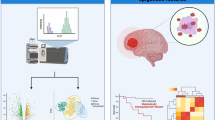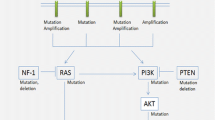Abstract
Introduction
CD146 is highly expressed in various malignant tumors and contributes to their malignancy phenotype, which involves metastatic and tumorigenic activity. However, studies on the expression and function of CD146 in brain tumors are limited.
Methods
We over-expressed or knocked-down CD146 in both conventionally cultured glioma cells and tumor spheres (TS). The distribution of glioma cells and their stem cells in different cell cycle phases was analyzed by flow cytometry using the stem cell marker CD133 and the glial precursor marker A2B5. CD146 expression was immunohistochemically examined in glioma tissues.
Results
The majority of glioma stem cells (GSCs) expressing CD133 were also CD146-positive. CD146 knockdown in GSCs significantly compromised cell growth. Cell cycle analysis revealed that most of the CD146 and CD133 double-positive cells were in the G2/M phase. Ectopic expression of CD146 in parental glioma cells resulted in cell cycle arrest of most differentiated cells in G0/G1 phase. In contrast, ectopic expression of CD146 in GSCs resulted in an increase in the number of CD133-positive cells in the G2/M phase. Furthermore, CD146 knockdown reduced the number of CD133-positive cells in the G2/M phase, which was consistent with effects of cell growth inhibition. Immunohistochemical analysis revealed that CD146 expression was significantly upregulated in World Health Organization (WHO) Grade III and IV glioma and positively correlated with CD133 expression.
Conclusions
CD146 is mainly expressed in dividing GSCs and may be a potential target for eradicating glioma stem cells.







Similar content being viewed by others
References
DeAngelis LM, Gutin PH, Leibel SA, Posner JB (2002) Intracranial tumors: diagnosis and treatment. Martin Dunitz, London, pp 367–394
Singh SK, Hawkins C, Clarke ID et al (2004) Identification of human brain tumour initiating cells. Nature 432:396–401
Singh SK, Clarke ID, Hide T, Dirks PB (2004) Cancer stem cells in nervous system tumors. Oncogene 23:7267–7273
Nonaka M, Yawata T, Takemura M et al (2015) Elevated cell invasion in a tumor sphere culture of RSV-M mouse glioma cells. Neurol Med Chir (Tokyo) 55:60–70
Johnson JP, Rothbächer U, Sers C (1993) The progression associated antigen MUC18: a unique member of the immunoglobulin supergene family. Melanoma Res 3:337–340
Shih IM (1999) The role of CD146 (Mel-CAM) in biology and pathology. J Pathol 189:4–11
Bardin N, Francès V, Lesaule G et al (1996) Identification of the S-Endo 1 endothelial-associated antigen. Biochem Biophys Res Commun 218:210–216
Wang Z, Yan X (2013) CD146, a multi-functional molecule beyond adhesion. Cancer Lett 330:150–162
Shih I, Wang T, Wu T et al (1998) Expression of Mel-CAM in implantation site intermediate trophoblastic cell line, IST-1, limits its migration on uterine smooth muscle cells. J Cell Sci 111:2655–2664
Covas DT, Panepucci RA, Fontes AM et al (2008) Multipotent mesenchymal stromal cells obtained from diverse human tissues share functional properties and gene-expression profile with CD146+ perivascularcells and fibroblasts. Exp Hematol 36:642–654
Russell KC, Phinney DG, Lacey MR et al (2010) In vitro high-capacity assay to quantify the clonal heterogeneity in trilineage potential of mesenchymal stem cells reveals a complex hierarchy of lineage commitment. Stem Cells 28:788–798
Johnson JP, Rummel MM, Rothbacher U, Sers C (1996) MUC18: a cell adhesion molecule with a potential role in tumor growth and tumor cell dissemination. Curr Top Microbiol Immunol 213:95–105
Wu GJ (2012) Dual roles of METCAM in the progression of different cancers. J Oncol 2012:853797
Verhaak RG, Hoadley KA, Purdom E et al (2010) Integrated genomic analysis identifies clinically relevant subtypes of glioblastoma characterized by abnormalities in PDGFRA, IDH1, EGFR, and NF1. Cancer Cell 17:98–110
Zeng P, Li H, Lu PH et al (2017) Prognostic value of CD146 in solid tumor: a systematic review and meta-analysis. Sci Rep 7:4223
Ricci-Vitiani L, Pallini R, Biffoni M et al (2010) Tumour vascularization via endothelial differentiation of glioblastoma stem-like cells. Nature 468:824–828
Wang R, Chadalavada K, Wilshire J et al (2010) Glioblastoma stem-like cells give rise to tumour endothelium. Nature 468:829–833
Soda Y, Marumoto T, Friedmann-Morvinski D et al (2011) Transdifferentiation of glioblastoma cells into vascular endothelial cells. Proc Natl Acad Sci USA 108:4274–4280
Sorrentino A, Ferracin M, Castelli G et al (2008) Isolation and characterization of CD146+ multipotent mesenchymal stromal cells. Exp Hematol 36:1035–1046
Jaksch M, Múnera J, Bajpai R et al (2008) Cell cycle-dependent variation of a CD133 epitope in human embryonic stem cell, colon cancer, and melanoma cell lines. Cancer Res 68:7882–7886
Jiang T, Zhuang J, Duan H et al (2012) CD146 is a coreceptor for VEGFR-2 in tumor angiogenesis. Blood 120:2330–2339
Li G, Kalabis J, Xu X et al (2003) Reciprocal regulation of MelCAM and AKT in human melanoma. Oncogene 22:6891–6899
Xu C, Wu X, Zhu J (2013) VEGF promotes proliferation of human glioblastoma multiforme stem-like cells through VEGF receptor 2. Sci World J 2013:417413
Sers C, Kirsch K, Rothbächer U et al (1993) Genomic organization of the melanoma-associated glycoprotein MUC18: implications for the evolution of the immunoglobulin domains. Proc Natl Acad Sci USA 90:8514–8518
Heimberger AB, McGary EC, Suki D et al (2005) Loss of the AP-2α transcription factor is associated with the grade of human gliomas. Clin Cancer Res 11:267–272
Acknowledgements
We thank Motoki Kondo and Sayo Kataoka (Science Research Center, Kochi University, Kochi, Japan) for technical assistance.
Funding
This study was funded by Grants-in-Aid (Nos. 25462267, 17K10867, 17H06920 and 18K08969) from the Ministry of Education, Science, Sports and Culture, Japan.
Author information
Authors and Affiliations
Corresponding author
Ethics declarations
Conflict of interest
All authors declare no competing financial interests.
Ethical approval
All applicable international, national, and/or institutional guidelines for the care and use of animals were followed. All procedures performed in studies involving human participants were in accordance with the ethical standards of the institutional and/or national research committee and with the 1964 Helsinki declaration and its later amendments or comparable ethical standards.
Informed consent
Informed consent was obtained from all individual participants included in the study.
Additional information
Publisher's Note
Springer Nature remains neutral with regard to jurisdictional claims in published maps and institutional affiliations.
Electronic supplementary material
Below is the link to the electronic supplementary material.
Rights and permissions
About this article
Cite this article
Yawata, T., Higashi, Y., Kawanishi, Y. et al. CD146 is highly expressed in glioma stem cells and acts as a cell cycle regulator. J Neurooncol 144, 21–32 (2019). https://doi.org/10.1007/s11060-019-03200-4
Received:
Accepted:
Published:
Issue Date:
DOI: https://doi.org/10.1007/s11060-019-03200-4




